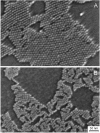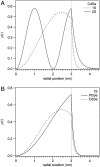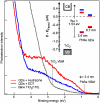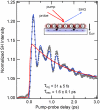Artificial atoms on semiconductor surfaces
- PMID: 21097704
- PMCID: PMC3024701
- DOI: 10.1073/pnas.1006665107
Artificial atoms on semiconductor surfaces
Abstract
Semiconductor nanocrystals are called artificial atoms because of their atom-like discrete electronic structure resulting from quantum confinement. Artificial atoms can also be assembled into artificial molecules or solids, thus, extending the toolbox for material design. We address the interaction of artificial atoms with bulk semiconductor surfaces. These interfaces are model systems for understanding the coupling between localized and delocalized electronic structures. In many perceived applications, such as nanoelectronics, optoelectronics, and solar energy conversion, interfacing semiconductor nanocrystals to bulk materials is a key ingredient. Here, we apply the well established theories of chemisorption and interfacial electron transfer as conceptual frameworks for understanding the adsorption of semiconductor nanocrystals on surfaces, paying particular attention to instances when the nonadiabatic Marcus picture breaks down. We illustrate these issues using recent examples from our laboratory.
Conflict of interest statement
The authors declare no conflict of interest.
Figures






Similar articles
-
Tuning the reactivity of semiconductor surfaces by functionalization with amines of different basicity.Proc Natl Acad Sci U S A. 2011 Jan 18;108(3):956-60. doi: 10.1073/pnas.1006656107. Epub 2010 Nov 10. Proc Natl Acad Sci U S A. 2011. PMID: 21068370 Free PMC article.
-
Ab initio nonadiabatic molecular dynamics of the ultrafast electron injection from a PbSe quantum dot into the TiO2 surface.J Am Chem Soc. 2011 Nov 30;133(47):19240-9. doi: 10.1021/ja2085806. Epub 2011 Nov 7. J Am Chem Soc. 2011. PMID: 22007727
-
Atomic and electronic structure at Au/CdSe interfaces.ACS Nano. 2008 Nov 25;2(11):2225-36. doi: 10.1021/nn8004608. ACS Nano. 2008. PMID: 19206387
-
Physicochemical evaluation of the hot-injection method, a synthesis route for monodisperse nanocrystals.Small. 2005 Dec;1(12):1152-62. doi: 10.1002/smll.200500239. Small. 2005. PMID: 17193409 Review.
-
Electron-conducting quantum dot solids: novel materials based on colloidal semiconductor nanocrystals.Chem Soc Rev. 2005 Apr;34(4):299-312. doi: 10.1039/b314945p. Epub 2005 Feb 17. Chem Soc Rev. 2005. PMID: 15778764 Review.
Cited by
-
In vivo monitoring of organ-selective distribution of CdHgTe/SiO2 nanoparticles in mouse model.J Fluoresc. 2012 Mar;22(2):699-706. doi: 10.1007/s10895-011-1005-1. Epub 2011 Nov 3. J Fluoresc. 2012. PMID: 22083240
-
Charge Transfer from Quantum-Confined 0D, 1D, and 2D Nanocrystals.Chem Rev. 2024 May 8;124(9):5695-5763. doi: 10.1021/acs.chemrev.3c00742. Epub 2024 Apr 17. Chem Rev. 2024. PMID: 38629390 Free PMC article. Review.
-
Carbon-Based Quantum Dots for Electrochemical Detection of Monoamine Neurotransmitters-Review.Biosensors (Basel). 2020 Oct 31;10(11):162. doi: 10.3390/bios10110162. Biosensors (Basel). 2020. PMID: 33142771 Free PMC article. Review.
-
Surface chemistry: key to control and advance myriad technologies.Proc Natl Acad Sci U S A. 2011 Jan 18;108(3):911-6. doi: 10.1073/pnas.1006671107. Proc Natl Acad Sci U S A. 2011. PMID: 21245359 Free PMC article.
-
Kinetic Control over Self-Assembly of Semiconductor Nanoplatelets.Nano Lett. 2020 Jun 10;20(6):4102-4110. doi: 10.1021/acs.nanolett.9b05270. Epub 2020 Mar 20. Nano Lett. 2020. PMID: 32163287 Free PMC article.
References
-
- Steigerwald ML, Brus LE. Semiconductor crystallites—a class of large molecules. Acc Chem Res. 1990;23:183–188.
-
- Klimov VI, editor. Semiconductor quantum dots. 2nd Ed. Boca Raton: CRC Press; 2010.
-
- Murray CB, Kagan CR, Bawendi MG. Synthesis and characterization of monodisperse nanocrystals and close-packed nanocrystal assemblies. Ann Rev Mater Sci. 2000;30:545–610.
-
- Kim J, Wong CY, Scholes GD. Exciton fine structure and spin relaxation in semiconductor colloidal quantum dots. Acc Chem Res. 2009;42:1037–1046. - PubMed
-
- Banin U. Light-emitting diodes—bright and stable. Nat Photonics. 2008;2:209–210.
Publication types
MeSH terms
Substances
LinkOut - more resources
Full Text Sources

